Blossoms in Every Bite: Discovering the Delight of Sakura Mochi
Sakura mochi, which takes its name from the most recognizable flower in Japan, has come to represent Japanese snacking. Find out the secrets behind its roles as a traditional sweet, festive snack, family meal, nutritional supplement, and Instagram sensation.
Introduction to Sakura Mochi: Japan's Spring Delicacy
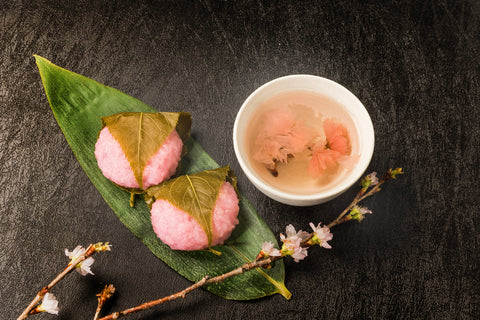
Let’s dive into the world of sakura mochi, one of Japan’s most popular confections. But it’s a lot more than that, especially during the spring season when it graces traditional festivals, including hanami and hinamatsuri.
Sakura mochi probably has the cherry blossom tree to thank for its fame. In Japan, the tree is known as “sakura,” and the pale pink color of its flowers is identical to the color of sakura mochi; hence, the name. Sakura leaves and flowers also serve as ingredients and decorations for the dish. The cherry blossom has a massive cultural impact, symbolizing life, death, and beauty. It’s only natural that some of that reverence be bestowed on its associated food.
In this post, we’ll explore everything there is to know about the mochi snack. Get ready to learn how it’s made, the different types, and where to find some, no matter where you are in the world. But first, we must start by answering one question.
What is Sakura Mochi? Understanding the Basics
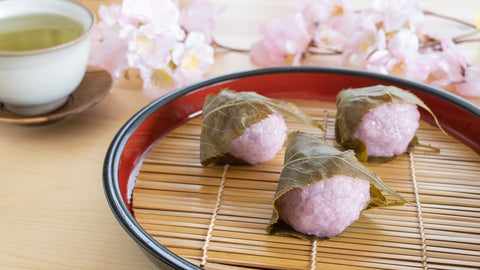
Sakura mochi is a sweet, pale pink glutinous rice cake filled with anko (red bean paste) and wrapped in a pickled leaf from a cherry blossom tree. The sakura wrapping leaf is also edible. Sakura mochi is a type of Japanese sweet or wagashi, called mochi (Japanese rice cake). It typically consists of tinted glutinous rice cake encased in a cherry blossom leaf, but some recipes include a decoration of cherry blossom flowers.
Sakura mochi was invented in 1717 by Yamamoto Shinroku, the founder of a teahouse called Yamamoto-ya. The teahouse, also called Chōmeiji, exists to this day and continues to sell authentic sakura mochi all year round. Sakura mochi variants are usually classified based on their regions of origin, with each region using a different form of glutinous rice. We’ll reveal more about the types of sakura mochi and what they contain later in this post.
The Cultural Significance of Sakura Mochi

The cultural importance of sakura mochi in Japan comes from the symbolic impact of its two major components: the sakura leaf or flower and mochi rice cake. Sakura represents various concepts, but the most prominent one is the fleeting nature of life and beauty. It is also a symbol of good fortune and undying hope. Mochi also has a similar cultural significance. It symbolizes good fortune and sustenance. When those two symbolic components combine, it’s little wonder that the result is a meal that has become a staple during festive celebrations.
Role of Sakura Mochi in Japanese Festivities
When it comes to serving sakura mochi at Japanese festivities, two events readily come to mind: hanami and hinamatsuri festivals.
Hanami (Cherry Blossom Viewing)

Hanami is the practice of visiting parks or riversides to view cherry blossoms during springtime. It’s one of Japan’s oldest and most revered traditions. During the cherry blossom season, a period that lasts through spring (March to May), millions of people from all over the world come to hanami spots in Japan to look at the flowers and celebrate their transient beauty. The majority of them gather in groups and enjoy picnics. No points for guessing the main snack served at these picnics: sakura mochi.
Hinamatsuri (Girl’s Day or Doll’s Day)

Hinamatsuri is an annual Shinto celebration in Japan. It takes place on March 3 and involves several rites, one of which is the display of Heian-themed dolls. Hinamatsuri is a cultural celebration of young girls and the bright future ahead of them. Before and on the day, families host parties where they serve a variety of customary dishes, including sakura mochi.
Ingredients of Sakura Mochi: A Closer Look

Before we discuss ways to make sakura mochi, you need to get a reasonable understanding of the roles of its ingredients. We mentioned the core ingredients earlier, but provide a closer look at each of them below.
-
Glutinous rice (flour): This is a sticky kind of sweet rice used to make mochi, hence its alias, mochigome. Glutinous rice is sweeter than regular rice and contains higher amounts of starch components known as amylose and amylopectin. It’s also the main ingredient for the rice cake. Some sakura mochi variations use glutinous rice flour instead.
-
Sweet red bean paste: This is also called anko. Making it involves blending boiled adzuki beans into a paste. Some of these pastes are sweetened with sugar. Anko functions as the filling for the rice cake.
-
Pickled cherry blossom leaf: This serves as the wrapping for the rice cake. It’s made by picking young cherry blossom leaves, particularly in May (the cherry blossom season). Each leaf is then scalded in boiling water and marinated in salt for several days. They add fragrance and flavor to the mochi while protecting it from dehydration. You can eat the leaf wrapping along with the rest of the food.
-
Sugar: This is used to further sweeten the glutinous rice during preparation.
-
Red food coloring: This comes as a powder or gel. It’s an artificial ingredient that gives sakura mochi its pink color. Alternatives include dragon fruit powder and beetroot juice.
-
Cherry blossom flower: This is an optional decoration. It’s pink and inedible, but can improve the visual appeal of sakura mochi.
The Making of Sakura Mochi: Traditional Techniques
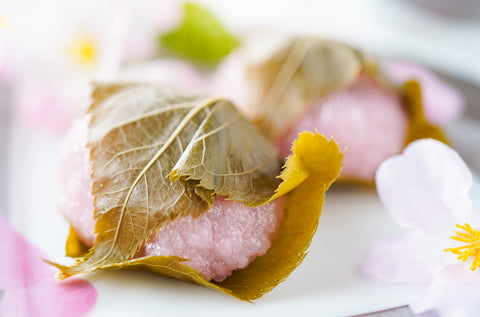
Traditional methods of making sakura mochi were simple and engaging. However, they took much longer than modern, homemade methods, which we’ll get to later in this post. For now, let’s dive into the exciting traditional process of making sakura mochi.
Making the mochi: There is a traditional mochi-making process called mochitsuki. Although it is nearly obsolete today, it used to be a ceremonial procedure common among Japanese communities. The process involves using a wooden mallet to pound steamed glutinous rice. The sticky rice is then cut and shaped into a round mochi ball.
Making the red bean paste: Adzuki beans are gathered and cooked in a bowl of water until they soften. After that, the next step is to press them through a sieve, using a wooden spoon or mallet, and discard the skins.
Salting cherry blossom leaves: In the past, fallen sakura leaves were gathered and placed in a bowl of saltwater. This served to preserve and marinate the leaves. They were then used to wrap mochi filled with red bean paste. Once done, the traditional sakura mochi was ready to eat.
Regional Variations of Sakura Mochi in Japan
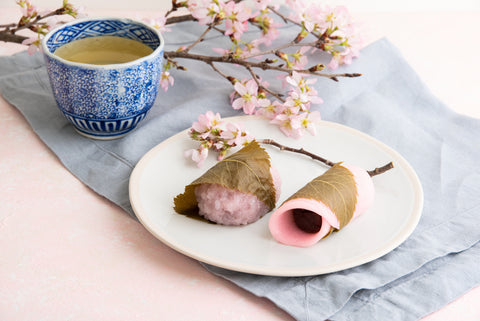
There are two main regional sakura mochi variants: Kanto-style or Chōmeiji and Kansai-style or Dōmyōji. The oldest one, Kanto-style, is popular in Tokyo. Glutinous rice flour or shiratama-ko, is the main mochi ingredient for this variant. The flour is made by grinding soaked and dehydrated glutinous rice into a fine powder. Also, Chōmeiji mochi is typically flatter than kansai-style sakura mochi. The second variant is from the Kansai region of Japan and is a delicacy in Kyoto and Osaka. Steamed, dried, and ground glutinous rice is used as the main mochi ingredient. This type of sakura mochi tends to be rounder. Also, you can see the rice grains if you look hard enough.
Sakura Mochi and Cherry Blossom Season: A Perfect Pair
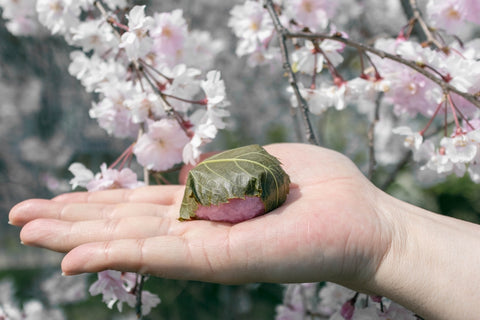
Sakura mochi and cherry blossom seasons complement each other. One is a beautiful period that provides the best leaves and flowers for the occasion, and the other is the snack that helps people enjoy the occasion.
As a seasonal food, sakura mochi tastes best during the cherry blossom season because of the blooming flowers and their leaves, which give off a wonderful aroma when pickled and added to the colored mochi. This fits perfectly with the concept of hanami festivals that occur during that time, making sakura mochi a symbolic treat that represents the beauty and transience of the sakura flowers. People gather to view cherry blossoms and eat sakura mochi at hanami spots like Ueno Park, Sumida River, Hirosaki Park, and Shinjuku Gyoen National Garden. You may struggle to find authentic sakura mochi outside of the cherry blossom season, which usually lasts from March to early May.
Health Benefits of Sakura Mochi: More Than Just a Sweet Treat

Sakura mochi is more than a tasty treat. Eating it in moderation can also improve your overall health. Below are the health benefits of consuming sakura mochi.
-
Highly nutritious: The adzuki red bean paste in the confection is packed with lots of nutrients. A healthy serving will give you adequate amounts of protein, fat, carbohydrate, zinc, iron, vitamin B, potassium, phosphorus, etc.
-
Improves digestion: Both the bean paste and glutinous rice have antioxidant properties that help with the digestion of food in the body.
-
Prevents chronic diseases: The ingredients in sakura mochi can help to prevent a number of common diseases, including diabetes and colon cancer.
-
Reduces inflammation: Sakura mochi provides a rich supply of vitamin B, copper, and zinc. Those nutrients are proven immune system boosters; hence, they help to cure inflammation.
-
Improves cardiovascular health: Sakura mochi is a low-cholesterol food that can help manage blood pressure and weight gain. This will improve heart health and allow blood vessels to function without obstruction.
How to Enjoy Sakura Mochi: Serving Suggestions

If you get your hands on delicious sakura mochi, you deserve to enjoy it to the fullest extent. The best way to eat sakura mochi is to pair it with green tea. That’s an unsurprising fact, as most wagashi taste better with a cup of green tea. However, the best green teas to pair with sakura mochi are genmaicha, matcha, and hojicha. Their bitter taste combines well with the floral sweetness of sakura mochi. The cherry blossom mochi is also a great companion to other kinds of snacks, especially dango (a Japanese rice flour dumpling). Sakura mochi and dango are usually served together at hanami picnics. The type of dango in this case is a customary version called hanami dango.
Never forget about the edible pickled cherry blossom leaf. Although eating it is optional, there are many people who are of the opinion that the sakura mochi experience is incomplete without eating the leaf. You can eat the leaf together with the rest of the meal or unwrap the mochi and both separately. It should fill your mouth with a savory and salty taste.
Finding Sakura Mochi in Japan: Where to Buy
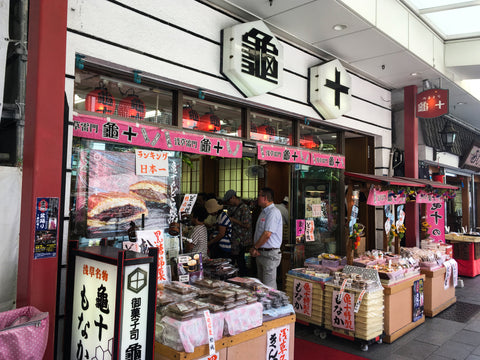
If you’re in Japan, you shouldn’t have any trouble finding sakura mochi. They’re available at traditional wagashi shops, supermarkets, and convenience stores. Many of the products sold at these locations are seasonal offerings for the cherry blossom season. Another way to get more sakura mochi is to hit the streets in the evening. You may find food stalls that serve the dish at affordable prices. Lastly, you can explore online platforms ready to deliver fresh sakura mochi to your home or office. Online shopping is also an ideal choice when sourcing ingredients used to make homemade sakura mochi.
DIY Sakura Mochi: Making It at Home
Even if you decide to make the sakura mochi at home, you’ll still need to buy the main ingredients from the store. For example, you can get pickled cherry blossom leaves and red bean paste from Asian or Japanese grocery stores. Outside of Japan, it becomes more difficult to get them and you may have to rely on online marketplaces. But if you have all of the ingredients, follow our simple recipe for making sakura mochi at home.
Ingredients needed for this recipe:
-
1 tablespoon of sugar
-
1 rice cooker cup (180 ml) of glutinous rice (short-grained)
-
¾ cup of water
-
Red food coloring
-
½ cup of anko (red bean paste)
-
Pickled sakura leaves
Step-by-step cooking guide:
-
Mix sugar, water, and one drop of red food coloring into a small bowl and whisk properly.
-
Rinse the rice multiple times using a large bowl and some water until it becomes clean.
-
Pour the contents of both bowls into a cooker, stir well, and add some more water.
-
Allow the mixture to settle for an hour and then cook it.
-
Divide the anko into several equal portions while the rice cooks.
-
Mash the cooked glutinous rice into a paste with a pestle, spatula, or rice paddle, and allow it to cool.
-
Spread a quarter cup of mashed, cooked rice on a piece of plastic wrap.
-
Place a ball of anko at the center of the spread rice.
-
Fold the rice over the anko, seal everything in the plastic wrap, and create an oval-shaped mochi ball.
-
Wrap the mochi in sakura leaf. One sakura mochi is ready.
-
Repeat the process from step 7 to make the other sakura mochi balls.
Sakura Mochi as a Gift: Conveying Spring Wishes

Sakura mochi can be gifted to friends and family as a way of sharing the joy and beauty of the cherry blossom season. Many people prefer to go on a picnic at one of the countless hanami spots in Japan, where they all eat wraps of sakura mochi. Also, people who exchange gifts during spring tend to send gift boxes filled with seasonal treats like matcha tea and sakura mochi. If you have someone special in mind who could use these treats, you should get them a Bokksu Snack Box subscription. They’ll receive a box of 20+ delicious Japanese snacks every month, and each box contains an interesting mochi treat!
The Aesthetic Appeal of Sakura Mochi: Instagram-Worthy Sweets
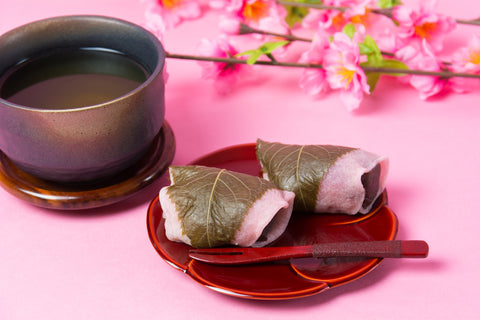
Granted, sakura mochi tastes fantastic, but we don’t talk enough about how good it looks! Its delicate pink hue and smooth look make it a worthy subject for photography. In fact, one quick search on a social media platform like Instagram will show viral photos of beautifully adorned sakura mochi getting thousands of likes.
Embracing the Season with Sakura Mochi
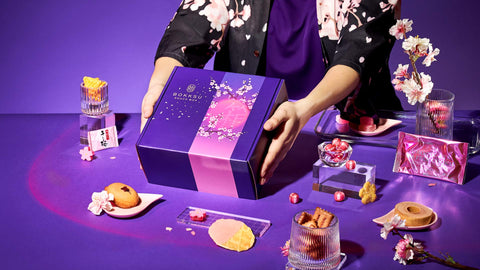
Embrace the cherry blossom season through the delightful experience of enjoying sakura mochi, a treat that captures the essence of spring in Japan. Getting yours is easy with Bokksu Snack Box on your side. We include a mochi treat in all of our boxes, and in springtime, sakura becomes our main focus.
Subscribe now and enjoy free delivery offers and other perks.
Author Bio







 Bokksu Snack Box
Bokksu Snack Box

























